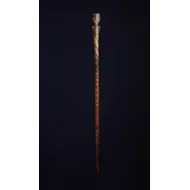A Tsonga , Southern Africa , Carved Wood Staff
A Tsonga , Southern Africa , Carved Wood Staff depicting a man with a headring and muscular shoulders , the shaft looped
Late 19 th Century
Size : 94 cm long , 37 ins long
Late 19 th Century
Size : 94 cm long , 37 ins long
The Tsonga lived in what was formerly the eastern Transvaal and Southern Mozambique . Their ruling elite claimed Zulu origin and retained certain Zulu elements of dress including the married man's headring .
Headrings were depicted on many figurative works from South Eastern Africa . It appears that Zulu warriors adopted this practice in the early 19 th century and it became an important symbol of the right to marry . In the 19 century Zulu Kingdom marriage was strictly controlled by the King who often subjected young men to long periods of service before they were allowed to marry and form homesteads . Presumably this practice underlined the powers of the King and also defined a man's marital status .
The practice of wearing a headring was then later adopted by other Southern African groups such as the Tsonga , but here the headring also signified the idea of age and status . The Tsonga headrings often depicted on carved figural objects tend to exaggerate the Zulu form and this probably reflects a desire to stress the importance and status of the wearer .
A photograph of the 1890's shows a Chief Ntschongui ( Chief of the Magude on the Nkomati River in South Mozambique ) sporting a large and thick headring which is echoed in the staff he is holding and also in this example ; ( see page 47 , The Art of South East Africa 2002 ) .
Headrings were depicted on many figurative works from South Eastern Africa . It appears that Zulu warriors adopted this practice in the early 19 th century and it became an important symbol of the right to marry . In the 19 century Zulu Kingdom marriage was strictly controlled by the King who often subjected young men to long periods of service before they were allowed to marry and form homesteads . Presumably this practice underlined the powers of the King and also defined a man's marital status .
The practice of wearing a headring was then later adopted by other Southern African groups such as the Tsonga , but here the headring also signified the idea of age and status . The Tsonga headrings often depicted on carved figural objects tend to exaggerate the Zulu form and this probably reflects a desire to stress the importance and status of the wearer .
A photograph of the 1890's shows a Chief Ntschongui ( Chief of the Magude on the Nkomati River in South Mozambique ) sporting a large and thick headring which is echoed in the staff he is holding and also in this example ; ( see page 47 , The Art of South East Africa 2002 ) .
A Tsonga , Southern Africa , Carved Wood Staff

SOLD



